Sue Deraney (Straight)
Note by Technical Support: This is not a personal
history web
page like most of the others.
Rather it is a letter that Sue sent to Friends (which we are) and
Family about some of her recent work.
But it poignantly illustrates what Sue has been up to.
But first ... Sue's yearbook picture ... then her letter.
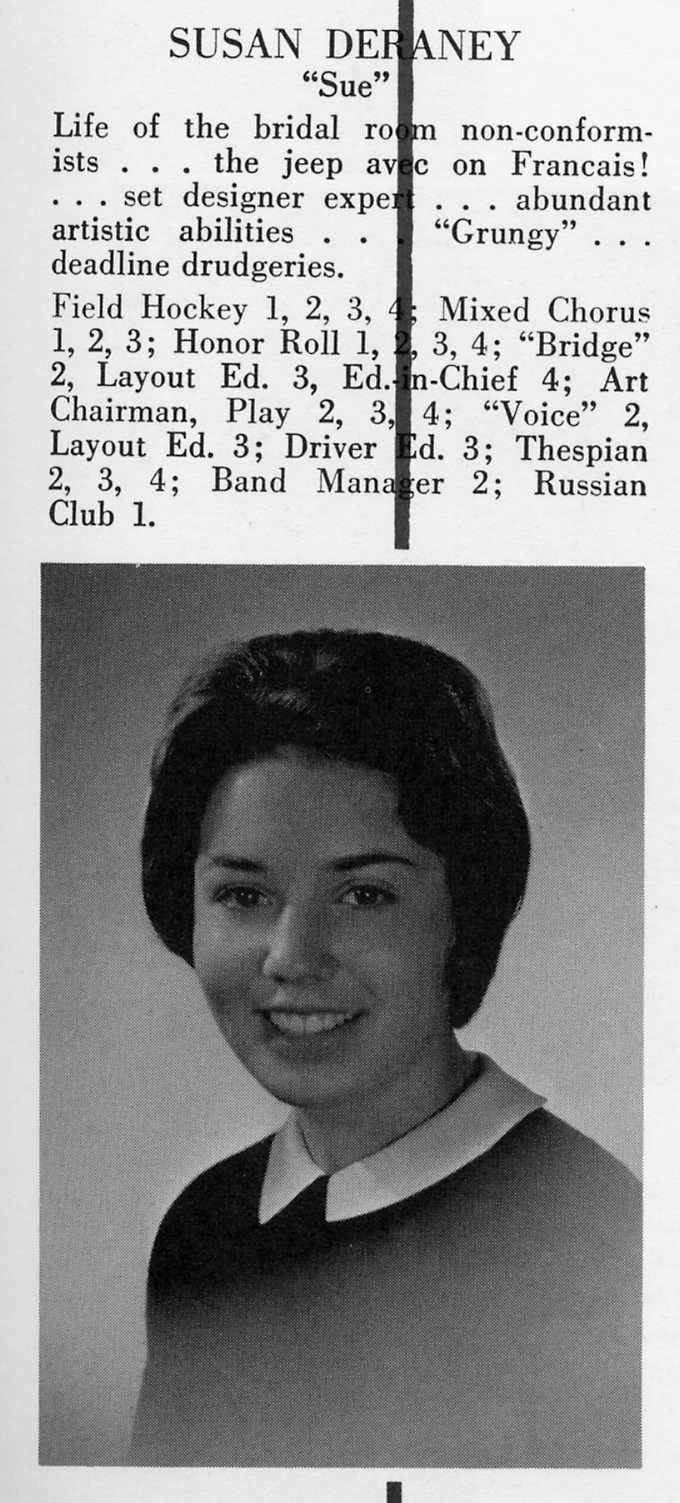
Dear
Friends and Family,
I have recently returned to China to go with a team of students
to a Hani ethnic minority village on a mountain about an hour from the
Chinese/Laotian border. I left my apartment at 7 am to take a bus to the
bus stop where I was to meet one of my staff people. That was the first
of a series of 5 buses and other modes of transportation that would
ultimately, 11 hours later, bring us to the village where we would be working
to help the villagers protect their minority culture. The long distance
bus (bus #3) sped us out of the city into the countryside surrounding Kunming.
More and more greenhouses are sprouting up near the city, producing the
local fabulous produce which I appreciate so much, and we passed miles and
miles of them until we began to pass older small villages and towns and an
occasional small city. The bus was taking us to Mojiang, the county seat
for the Hani village we were going to, but a full 3 hrs from the small town at
the base of the mountain. This village is the furthest away of any
village we have worked with, but we set up the project last year at the behest
of a Kunming school principal we have worked with, who comes from that
village. Last year, i was sidelined by my mini-strokes and was unable to
come to China until May, so I missed going to this village. At Mojiang
we hurried to a small restaurant near the bus station to eat our lunch, before
boarding an 18 person small bus we had rented for the mountainous ride to the
local town. It's the kind of bus that you slide off the seat as you go
around a curve, and this trip was all curves. Some of the students
looked a bit green around the gills, but luckily my stomach held. The
view, however, from the road was spectacular. Cascades of mountains,
softened by the smoke of burning fires, terrace rice and tea fields cascading
down their sides for 1000 feet, village people walking on the side of the road
back home from the fields. It was beautiful, even if we all hand to hang
on tight. We arrived in the town as it dusk was descending. Four
members of the team had left for the village 5 days before and had made all
the preparations (and dinner for us), but there was quite a way to go yet.
The whole team left the bus, picked up their packs and began the 2 hour
hike, in the dark, up the mountain to the village. Except me and the
student who was to be my translator. Arrangements had been made for two
motorcycles to come down from the village and bring us back up, along with a
couple of heavier suitcases. As Song Yuan and I waited for them, it got
darker and darker.. We really weren't sure what we had gotten ourselves
into, but there was nothing to do but wait by the side of the road. I
must say, I was really grateful that I wasn't left alone there, unable to talk
to anyone, but it was a challenge for her too, because she was from another
province and was having difficulty understanding the local dialect. But
we could cheer each other as we waited. Finally, two villagers showed up
on motorcycles, quickly loaded up the baggage and put us each on one of
motorcycles and off we went. It was really fully dark now and as we left
the town, it was clear that the dirt road was really in bad shape. It is
one lane wide, but often half of that is so washed out that it is impassable.
All we could see was the circle of light made by the head light as we
swerved around boulders and wash outs. I had been on this road 2 years
earlier when we went to investigate the village in the first place, and then
too on a motorcycle, so I knew that along most of the road there was a 1000 ft
drop off and no barrier of any kind. But blessedly, we could not see
that on this trip. We could barely see anything. About 1/3 of the
way up, we passed the team walking with flashlights, something we would become
extremely accustomed to. But it was a slow ride too, as the drivers
worked to negotiate the difficulties of the road. About an hour after we
got on the cycles, we finally arrived at the village, barely able to stand,
and were taken to the outdoor kitchen where the team leaders were preparing
dinner woks over open fires. It took the rest of the team another 1 1/2
to get there. We had finally arrived!
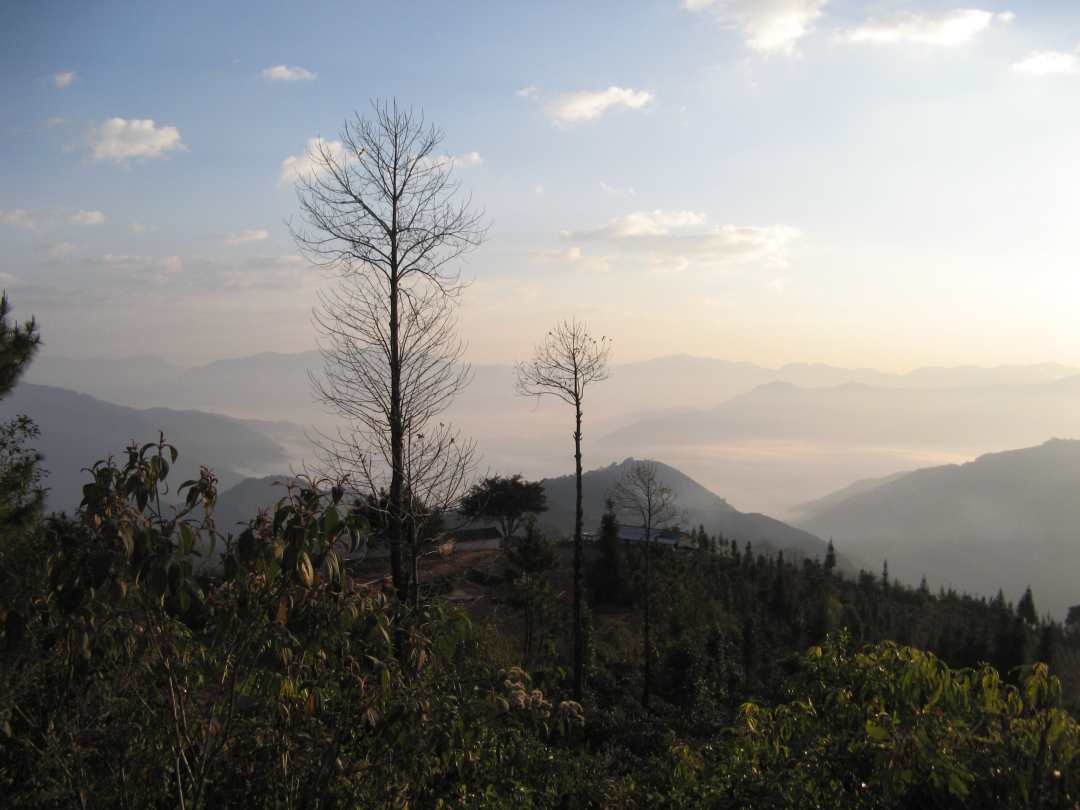
Mountain Ranges
The amazing thing is that no one complained about anything, not
the walk, nor the conditions in the village. Song Yuan and I were given
a bed to share (a size somewhere between a single and a double) in a spare
room, whose other half was filled with pig feed. The room itself was
about 8x10. The rest of the team was sleeping on hard low tables the
same size with one quilt each, 2 to a table. All the girls in one room,
the boys in the other. The outhouses were a bit of a way from the
sleeping quarters and very primitive. After dinner we went to our
respective places, us on the motorcycles who had waited for us, the rest
walking down the mountain to the village. The head man of the village
and the other leaders had come to join us for dinner, along with our drivers
and welcomed us with toasts. It is hard to imagine American students
managing all this, and particularly remaining cheerful. But it was to
remain this way throughout the 10 day trip, with everyone tired, yes, but
without complaint.
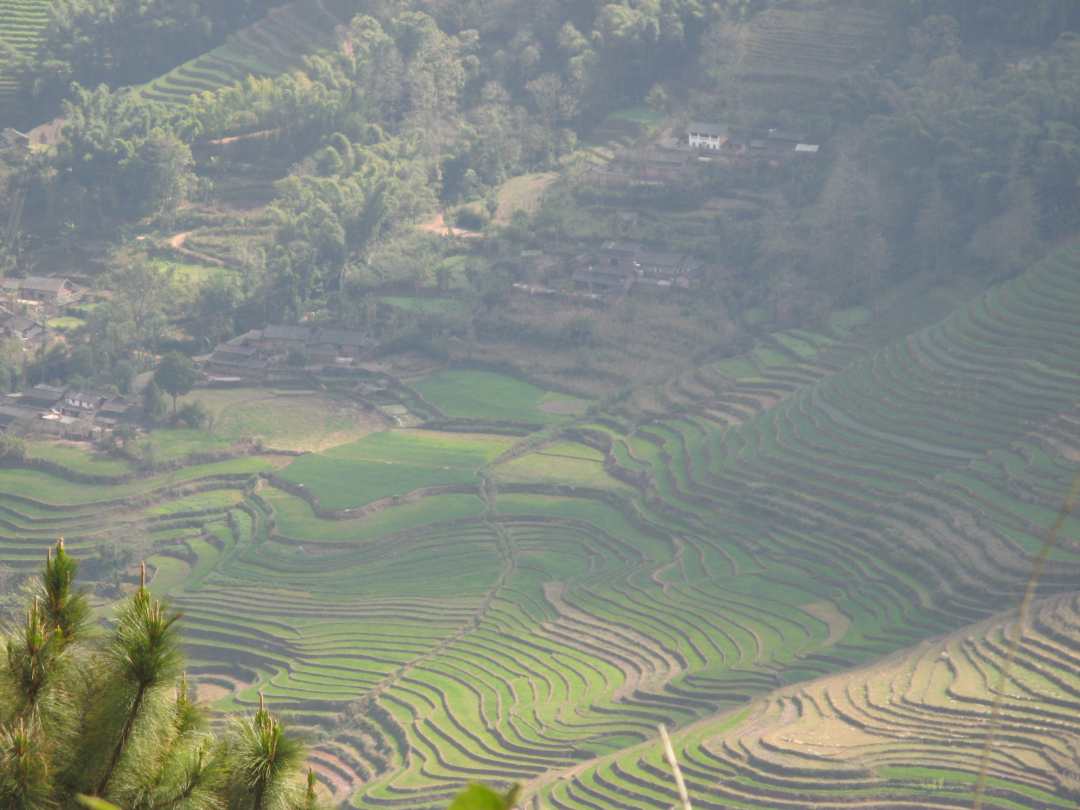
Terraced Rice Fields
The next morning, we were finally able to see the whole
village, since we had to hike back up the mountain to get our breakfast.
We would have to do this 3 times a day. It was definitely a
challenge for me. No other village I had been to was situated in this
way, on a mountainside. When we arrived what awaited us was a
spectacular view, much like what we had seen in that last small bus, but this
time, with morning mists between the mountains and a newly rising sun. We
were in awe. This is the view that greeted us at each meal. Our
tables were lined up to look out at that while we ate. It was incredibly
peaceful, only the sound of roosters and dogs and then of course, the
occasional motorcycle on the way to the town, Chinese pop blaring from the
portable recorders. Is there any place in the world still immune to
this? I would guess not. The task for most of the team that day
was to tour the village, meet some of the villagers and then to spend the
afternoon climbing higher up the mountain to gather firewood for the cooks.
It took hours but they returned with enough for most of the week. The
villagers were very welcoming, asking us to eat with them, giving us candies,
inviting us into their houses to sit. We were all invited to the
headman's house for a welcome dinner outdoors on the cement "patio"
that separated the house from the chickens and the pigs and the kitchen
gardens. Most of the houses in this village are in good shape,
relatively speaking though, only the old section of the village is in need of
much repair and the people there live a pretty difficult life.
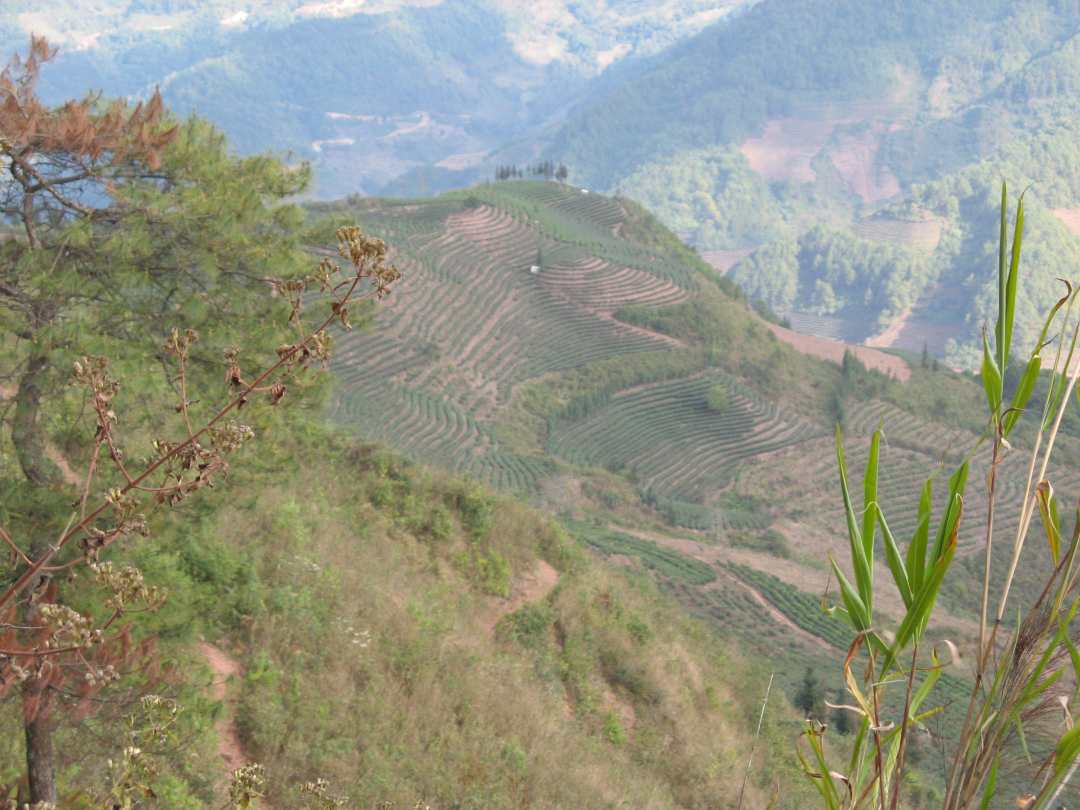
Terraced Tea Fields
Our main project is one of cultural preservation. It
takes two forms, the building of a large cement area where the whole village
can gather for weddings, dances, ceremonies, and of course, basketball (it is
an obsession in china among men and boys), and the setting up of a structure
by which the elders (or at least middle aged) teach the children and young
girls about the culture (something they are not so interested in learning).
We spent our mornings going from household to household collecting
information about the Hani culture, the dances, songs, clothes, ceremonies,
and food. We wanted to find out who knew these things too, so that we
could set up the village team that would go on training the younger ones.
We took family photos of each family and if someone in the family had
the traditional clothes, we asked them to put them on for the photo. This
has become a very popular thing that we have been doing in all of our
villages. Village families have never had photos of themselves, nor
cameras for that matter. Most have never seen themselves in a picture,
and ALL of them want the photos taken. We had only managed to take
photos of about 1.2 the families last year and all of those families had them
prominently displayed in their houses. Some of the team was designated
to gather the children in the village and to take them to the community house
to play and draw as a way of getting to know them. They went door to
door and at first not many of the children would come, but as the days went
by, more and more of them would arrive, and often their mothers or
grandmothers would come too, many with babies on their backs. We had
asked the head man's wife and her best friend, both of whom had the
traditional clothes and knew the dances, to come one morning and show the
clothes to the young girls. We had also put pictures of last years trip
up on the wall. It was amazing. More and more of the women and
children kept arriving, to learn and to look at the pictures of themselves and
friends. There was such an excitement in the air. At first, none
of the girls were willing to try on the clothes, but one of the university
students REALLY wanted to and did, and you could watch the girls become more
interested. Finally, one of the village girls decided that she too
wanted to put on the clothes and have her picture taken. Step by step.
But we have noticed that when the university students show interest in
the culture and honor it, the villagers begin to see that it might be valuable
after all, rather than just backward. When we were leaving, I heard the
daughter of one of the two teachers ask her mom if she would teach her to do
the embroidery. it was clear that she had never been interested before,
even though she had to be about 35. It is an interesting process.
We still don't know where it will end up-it is not known if a minority
culture can keep itself from being absorbed into the mainstream culture.
There is much of value to learn from these indigenous people and
mainstream cultures are poorer without this knowledge. We can only give
it our best effort.
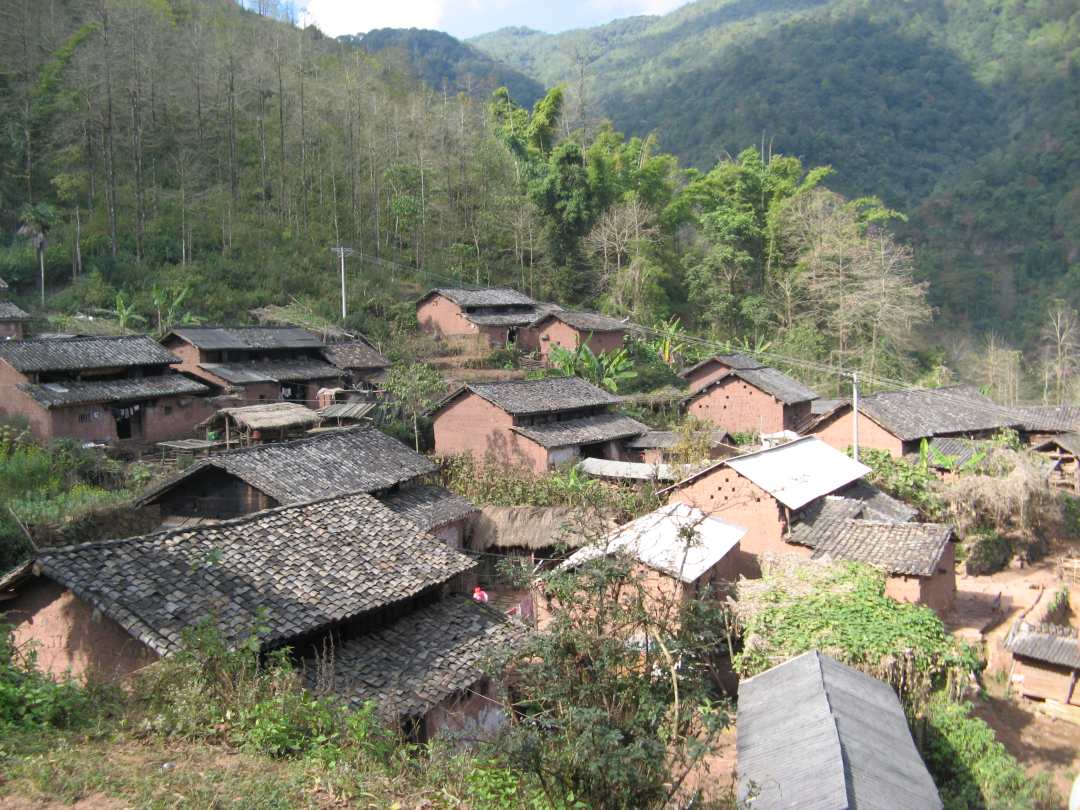
The Village
In the afternoons, we worked on the ceremonial area. That
consisted of gathering rocks from the mountainside with large chains of both
volunteers and villagers passing rocks up the line. That task took a
couple of days and then the rock had to be brought down in the one village
truck to the area. But it was wonderful to see. There was such a
team spirit. It was set up with one line of villagers and one line of
volunteers and a third of villagers down the road a bit. The villagers
would sing a song and then the students would sing one back to them. At
one moment when there was a lull, a lovely mans voice floated around the bend
from the third team, singing a traditional Hani song to us all. I find
that there is something very special in this. The other task was to
level a large area. It sound simple, but it wasn't. In both the
rock gathering activity and the levelling activity, there were 60 or more
people involved for several days. Each village family was required to
provide one member for this task, plus all the volunteer team. We had
only pick axes and hoes, and a kind of levelling blade made by the villagers
and operated by one person pushing a handle and two people pulling on ropes in
the front. We would hoe up mounds and they would pull the mounds across
the area to fill in the lower parts. Ingenious!. It was gruelling
work. We only worked in the afternoons, but the villagers worked from 10
to 5. They only eat 2 meals a day, one at about 9:30, the other at about
5:30. They are amazing workers, both men and women, and very, very
strong. But our students, untrained as they are and having spent their
whole lives studying, worked hard to keep up.
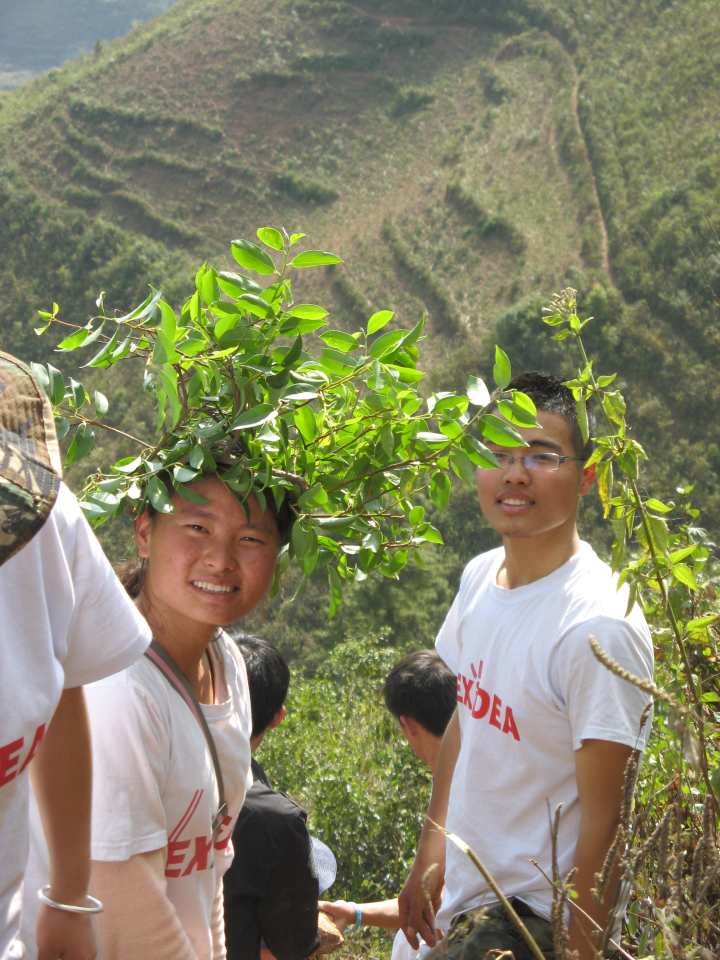
Hauling Rocks
There were challenges too. Unbeknownst to us, the village was
celebrating the New Year quite a bit earlier than the traditional Chines Han
celebration, and thus occurring during our time in the village, meaning that 2
days would be lost on the building of the ceremonial area since the villagers
would not be available to work. This meant that the project was not done
when we left, something we really try not to do, because there is no
completion for the team and for some it is very disappointing. We did
however, get to celebrate with the villagers. Each family killed a pig
on their front door step. In the house where we were staying, it was at
dawn right outside our bedroom door. It is a screaming affair and quite
unnerving to a novice to the practice. Every household was cutting up
pig in front of their houses when we came to visit. Many gave us pork
for our meals. The other thing that delayed our plans was that one of
the elder women died the second night we were there. We had met her the
first day. The students were quite upset about this and of course, the
whole village had to stop everything it was doing to go to the funeral
ceremony the next day and then the burial o the mountain. All in all we
lost 3 of our working days. There was nothing that could be done about
it. And for me, there was the physical challenge of hiking up and down
the mountain, often on slippery, rocky trails. I fell twice. The
students took to holding my hand on the steep places. I felt old and
incapable and didn't like the feeling.
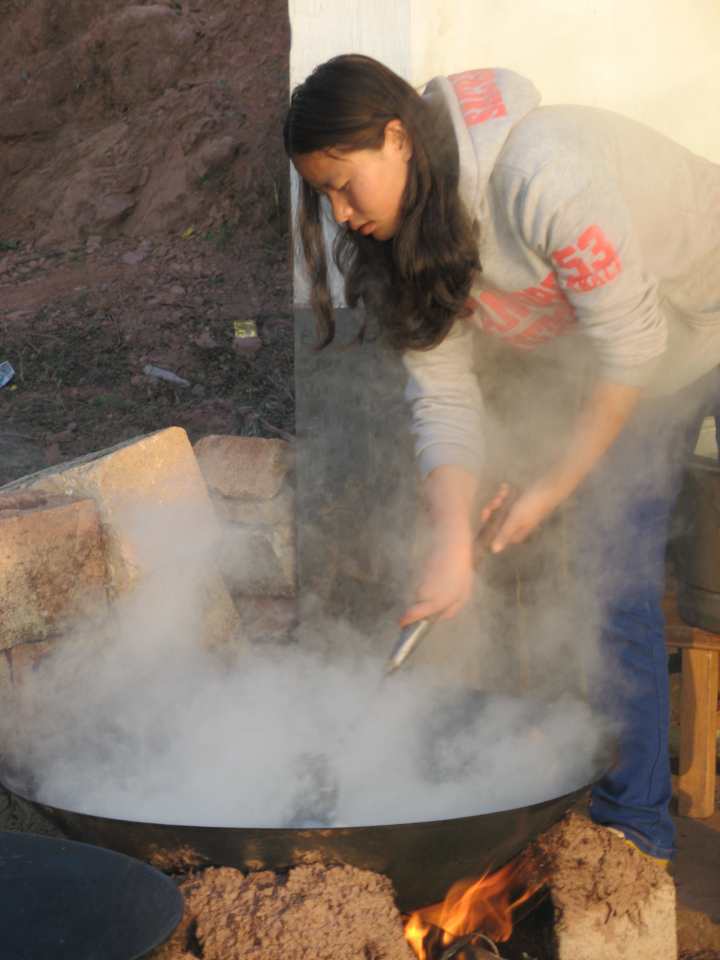
Cooking Dinner
Each evening, the team had a sharing meeting where each person
shared some special experience of the day or their feelings about something.
Song Yuan had to simultaneously translate for a full hour and a half
each night. She was a real trooper, and because we were sharing a bed
also, we became friends. She was a great team member too. They
also gave out an award to some outstanding effort to one of the team. One
night they gave to me for inspiring them while we were working on the
levelling of the ceremonial area. They told me that every time they
wanted to stop, they would look over and see me continuously hoeing or moving
earth and it would keep them going. They were amazed that I could do the
work. Somehow, that softened the feelings I had been feeling with the
mountain hiking. As the days progressed, more and more villagers would
show up at our kitchen area after dinner. Some of them were practicing
for the performance on the last night, others came to talk. There were
mixed groups of volunteers and village young people working on a dancing and
singing routine, while a mixed group of boys were working on a kungfu routine,
I was working on an English song with a couple of the team leaders.
One night about 8 young villagers and another group of about 6 older
villagers stayed and we built a big fire to sit around together. Again
the volunteers and the villagers took turns singing to each other. One
man played a flute and another an harmonica. One villager sang us
traditional Hani songs. We did Hani dancing around the fire, all of us
together at the end. It was always quite dark when we finished, but this
night we went on to have our sharing meeting, albeit a bit shortened. It
was a magical evening.

Hani After Class
Perhaps the saddest thing that happened on the trip was that it
poured on the last night and we were unable to hold the final celebration
everyone had been working so hard on. I feared that there would be a lot
of moping around, but not one person did. They took it all in stride.
The next morning we were to walk back up the mountain and out, a trip of
3 hours. It would make us late for our bus to Mojiang. But as dawn
began 16 motorcycles and a 4 wheel drive SUV were waiting to take all of us
out. It included one with the head man and the car was driven by the
principal from the school in Kunming who had come to help. So, though
there was no whole village gathering the night before with us, the generosity
and gratitude of this village was expressed in another way- motorcycles!
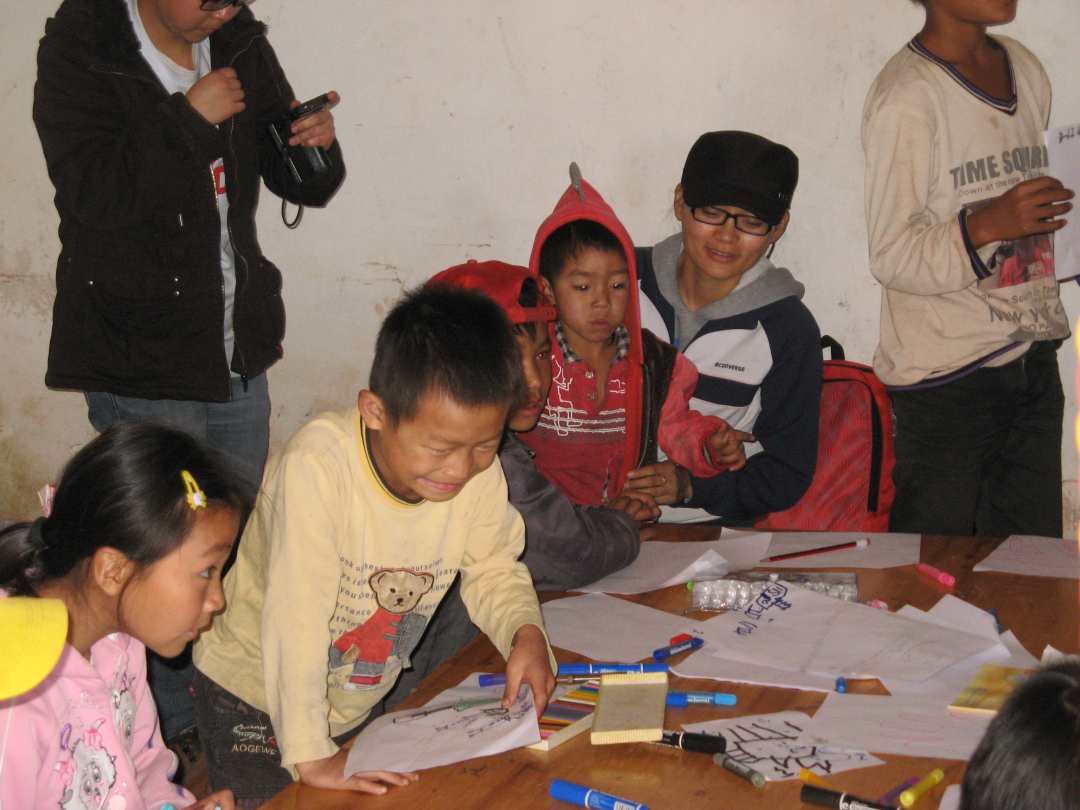
Children's Art Class
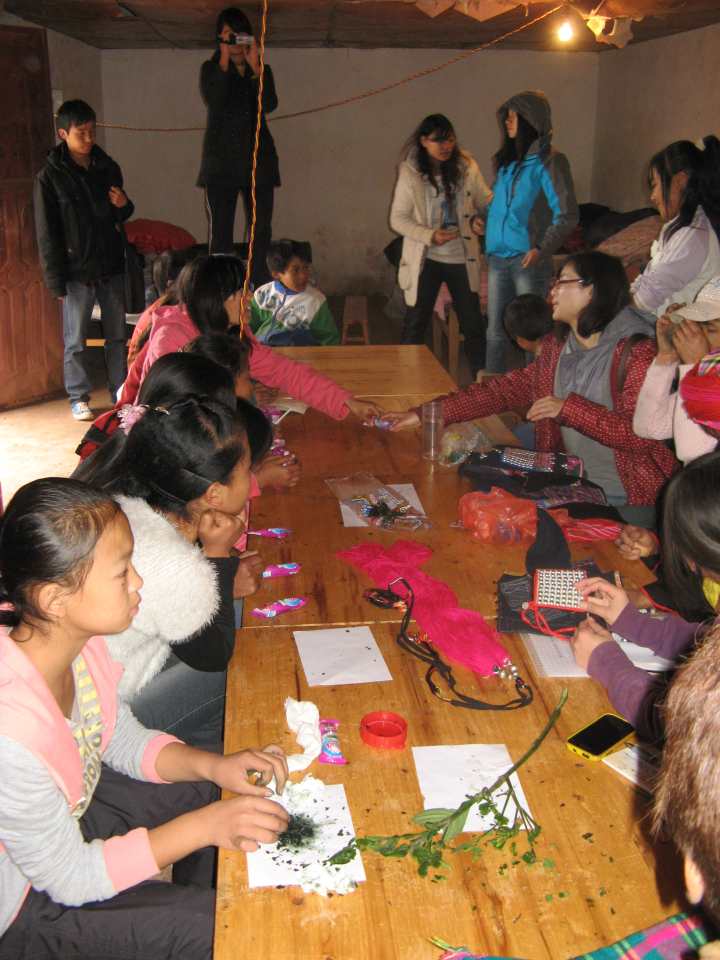
Class on Traditional Clothes
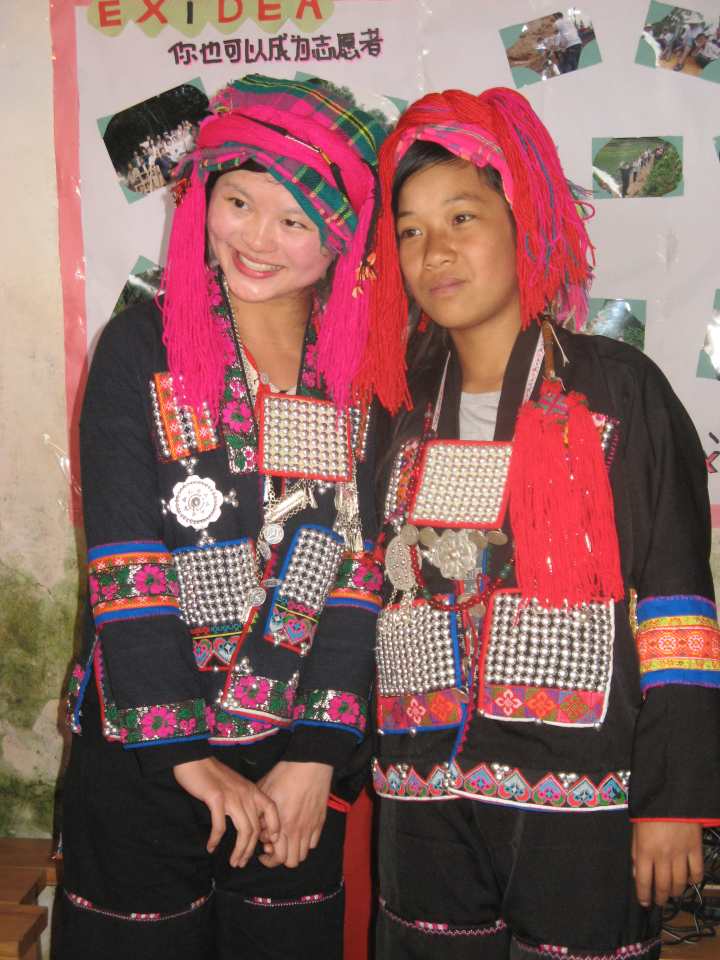
Hani Girl and Volunteer










